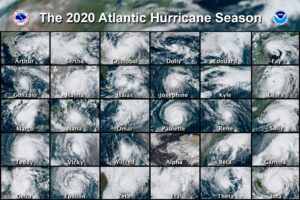
November 30 marks the end of the record-breaking 2020 Hurricane Season for both the Central Pacific and Atlantic basins; December 1 marks the first day of meteorological winter. While tropical threats haven’t been in the forecast for a while, winter storm threats have, with a few arriving in November.
December 1 marks the arrival of the 2020-2021 Meteorological Winter Season. Meteorological winter is a three month period that runs through to the end of February. In the Northern Hemisphere, it is the coldest three month period of the year. Meteorological Winter is different from Astronomical Winter, which is based on when the sun reaches the most southern point on the globe, the Tropic of Capricorn. If you are right on the Tropic of Capricorn at 12 noon on the first day of Astronomical Winter, the sun will be directly overhead. This year, that date is Monday, December 21. While winter is starting in the Northern Hemisphere, summer begins in the Southern Hemisphere. The word “winter” comes from the Germanic “wintar” which in turn is derived from the root wed meaning ‘wet’ or water’, and so signifying a wet season. In Anglo-Saxon cultures, years were counted by the winters, so a person could be said to be “2 winters old”.

While meteorological winter begins, people are still picking up the pieces from a destructive 2020 hurricane season that impacted the Atlantic hurricane basin moreso than the Central Pacific basin this year.
In the Atlantic, the season was extremely busy, with a record 30 named storms, 13 hurricanes, and 6 major hurricanes. A record 12 named storms made landfall in the United States. Due to the excessive number of named storms, the National Hurricane Center had to rely on letters of the Greek alphabet to name storms.
While the central Pacific was active, Hawaii was able to escape relatively unscathed. Hurricane Douglas traveled dangerously close to the state in July, almost striking the island of Oahu head-on. Fortunately, the storm was just far enough off-shore to limit serious impacts across the state. No other storm
While meteorological spring will begin on March 1, 2021, the 2021 Hurricane Season for both the Atlantic and Central Pacific basins will start on June 1, 2021. Tropical cyclones do form time to time in the off-season in both seasons. As an example, in an active 2005 Atlantic hurricane season, a named storm formed at the end of December. Should any storm form before the end of the year, it would be named after the next letter to be used with the Greek alphabet. Should a storm form after January 1 and become named, it would use the list of names set aside for the 2021 hurricane season.